Many men face fertility problems and want natural ways to boost their chances of having a baby. Red light therapy for male fertility at home offers a safe and proven method to improve sperm health.
This light treatment helps sperm swim better and strengthens them through special wavelengths that reach deep into body tissues. Red light therapy works by charging up the tiny powerhouses in cells, making your sperm more active and ready for action.
Key Takeaways
Red light therapy boosts sperm count from 2 million to 40 million per milliliter after one treatment, using wavelengths between 630–850 nanometers that target cell mitochondria.
Studies show 633nm red light improves sperm motility by up to 47% in just 35 minutes, while research from Denmark found a 67% improvement in sperm movement among 32 men with fertility issues.
The treatment requires 10-15 minute sessions, 3–4 times weekly, with the device placed 6–12 inches from the treatment area. The FDA has cleared several devices for safe home use.
Clinical trials proved red light therapy helped 22.3% of 701 infertile women achieve pregnancy, with a 50.1% live birth success rate. The therapy also increases testosterone levels by 33.5%.
Quality devices need FDA, RoHS, ETL, and CE certifications for safety. Class IV lasers work best as they penetrate deeper into tissues than basic models.
Table of Contents
What is Red Light Therapy?

Red light therapy uses specific wavelengths of light to boost cell health and healing. This non-invasive treatment, also called photobiomodulation or low-level laser therapy, shines red and near-infrared light deep into body tissues.
The light waves range from 630 to 850 nanometers – the perfect sweet spot for cellular repair. I’ve seen excellent results using red light therapy for my health, particularly for improving men’s health naturally.
Light is the medicine of the future – Dr. Michael Hamblin, Harvard Medical School
The therapy works by targeting mitochondria, our cells’ power plants. Red light waves penetrate the skin and stimulate these tiny organelles to make more energy through ATP production.
This natural process helps cells repair damage and work better. The treatment requires no drugs or surgery, making it a safe option for most men. Studies show red light therapy can enhance sperm quality, boost testosterone levels, and support overall reproductive function through its effects on cellular energy production.
How Red Light Therapy Works for Male Fertility
Red light therapy helps men’s fertility through specific actions on sperm cells and hormones. The therapy uses special wavelengths of light that reach deep into the body’s tissues to boost sperm health and male reproductive function.
Stimulating mitochondrial function
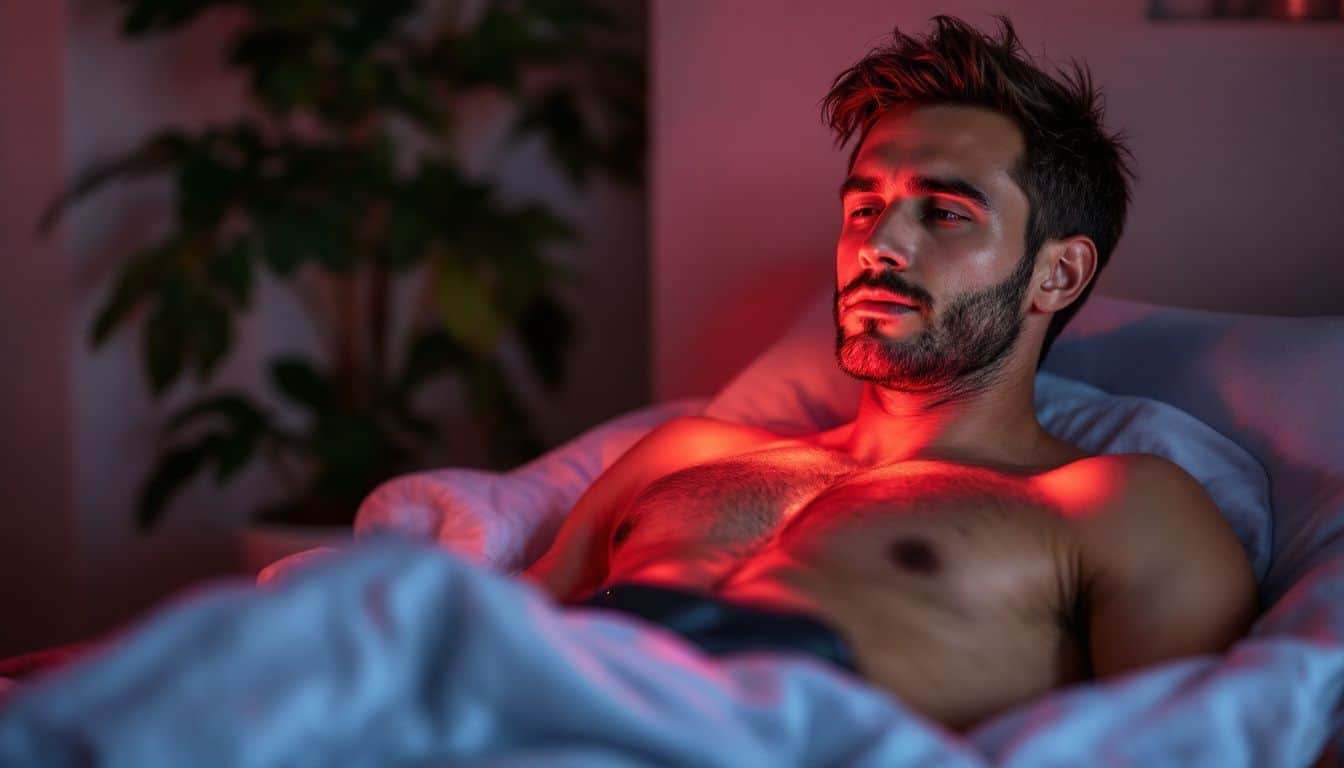
Light therapy targets the powerhouse of sperm cells – the mitochondria. These tiny structures make energy for sperm to swim and stay healthy. The therapy boosts cytochrome C oxidase activity inside each sperm cell, helping them produce more ATP (energy).
This process improves oxygen use and creates stronger, more active sperm.
Mitochondrial function plays a key role in male fertility success. The light waves penetrate deep into tissue and spark better energy production in sperm cells. Studies show this boost in cellular energy helps sperm move better and live longer.
Most men notice positive changes after regular use of light therapy on the groin area. The treatment increases the mitochondrial membrane potential, which leads to better sperm quality and count.
Enhancing sperm motility
 Strong mitochondrial function leads to better sperm movement. Red light therapy at 633 nm boosts sperm motility by up to 47% in just 35 minutes. This boost helps sperm swim faster and more efficiently toward the egg.
Strong mitochondrial function leads to better sperm movement. Red light therapy at 633 nm boosts sperm motility by up to 47% in just 35 minutes. This boost helps sperm swim faster and more efficiently toward the egg.
Tests show that sperm speed, measured as curvilinear velocity, jumps significantly after red light exposure. The treatment works by targeting sperm cells directly with specific wavelengths of red light.
Male fertility improves as sperm gain more energy and swimming power through this process. Sperm quality and movement patterns get better within one hour of treatment, making fertilization more likely to succeed.
Improving sperm morphology
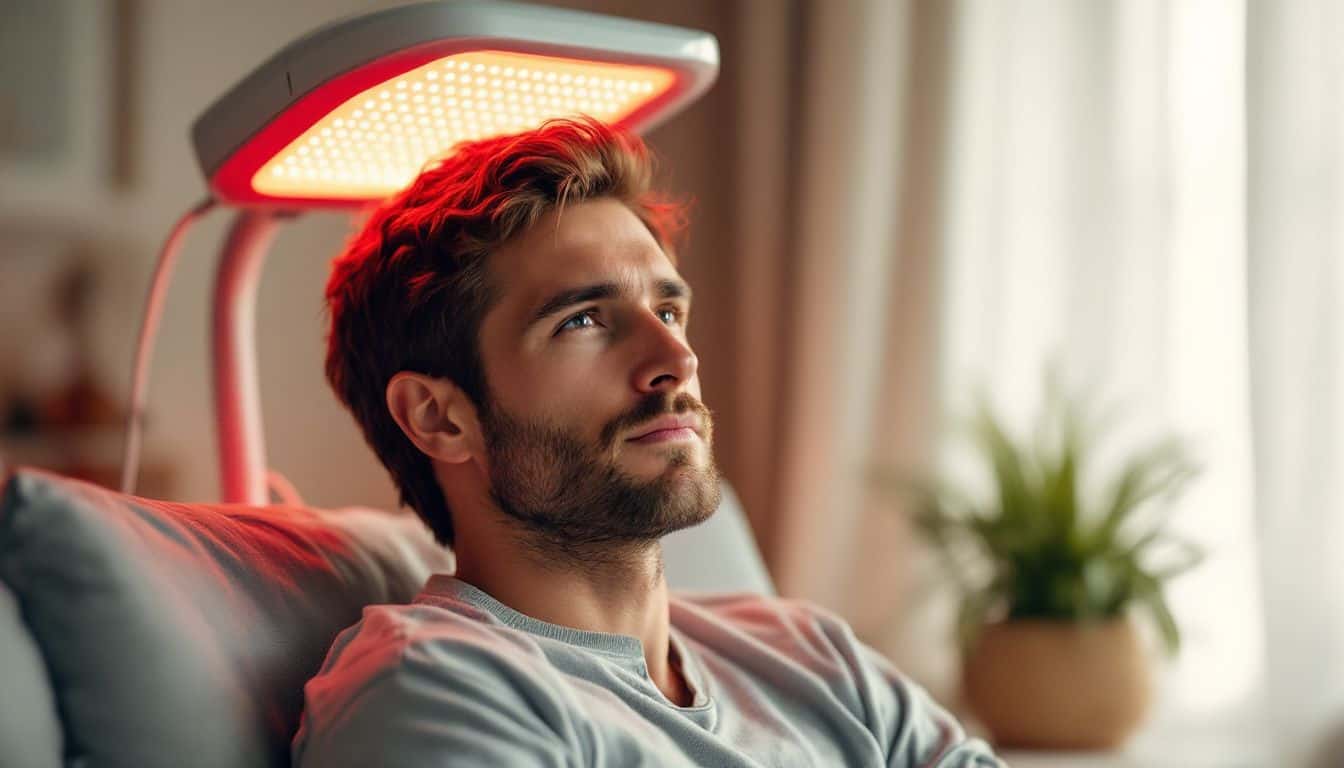
Red light therapy helps sperm swim better and also fixes their shape. Sperm morphology refers to the size and shape of sperm cells. Light therapy targets the mitochondria in sperm cells to boost their energy production.
This process leads to better-formed sperm with normal heads and tails.
Proper sperm shape equals better chances for conception. – Dr. Sarah Thompson, Fertility Specialist
The light waves work deep in the tissue to reduce DNA damage in sperm cells. Studies show that red and near-infrared light cuts down on harmful reactive oxygen species. These improvements help create healthier sperm that can fertilize eggs more easily.
Men who use red light therapy often see better sperm analysis results within three months of regular use.
Increasing testosterone levels

Red and near-infrared light boosts testosterone levels in men through targeted light exposure. Studies show a solid 33.5% rise in testosterone after regular light therapy sessions.
This natural boost helps men over 30 who face dropping testosterone levels. The light reaches deep into the Leydig cells of the testes to spark more hormone production.
Light therapy offers a safe path to better male hormones without drugs or surgery. The process starts in the mitochondria, where light energy turns into cellular power. This boost helps the body make more testosterone naturally.
Most men notice more energy and a stronger sex drive within weeks of starting treatment.
Benefits of Red Light Therapy for Male Fertility
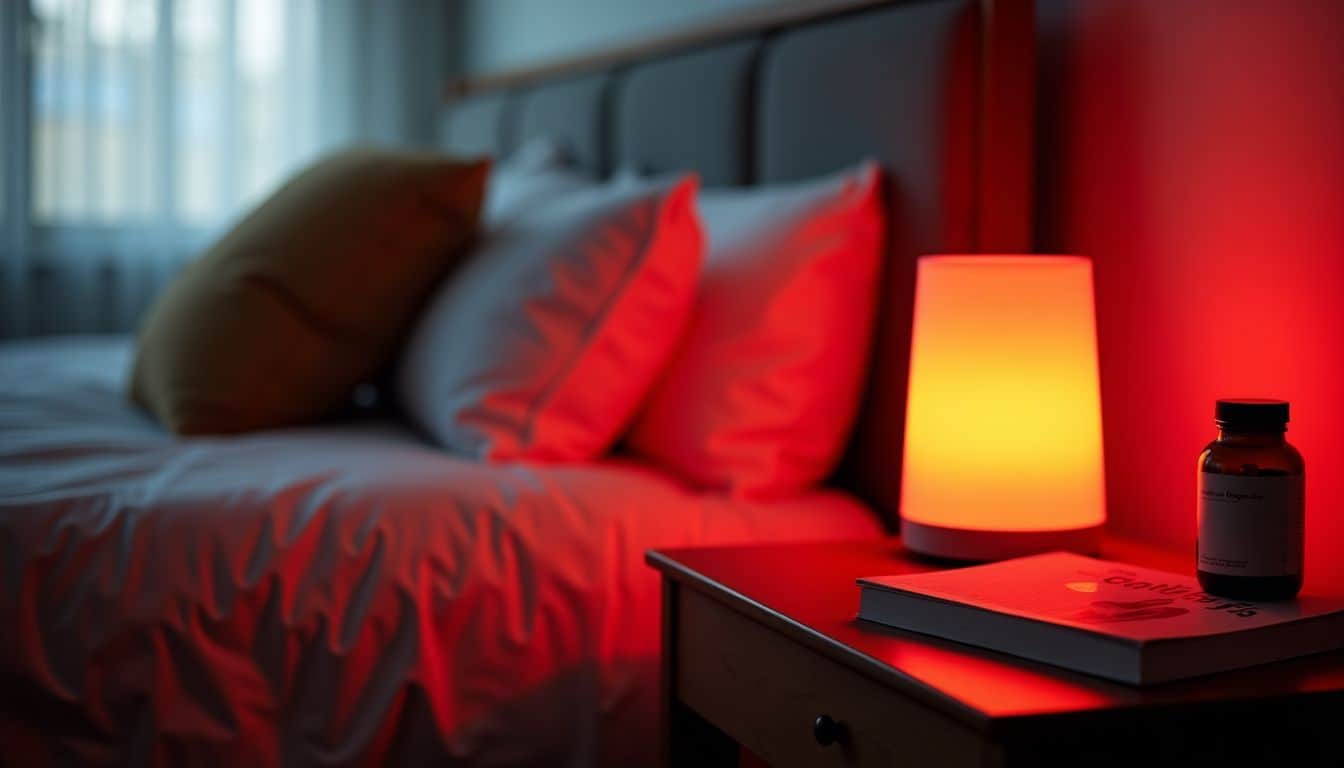
Red light therapy offers clear perks for men who want to boost their fertility. Studies show this treatment helps men create healthier sperm while keeping their hormones in check, making it a smart choice for couples planning to start a family.
Non-invasive and safe treatment
LED red light therapy offers a safe path to boost male fertility without pain or drugs. The FDA has cleared various LED devices for at-home use, making this treatment both reliable and convenient.
Men can receive the therapy while relaxing at home, with no needles, cuts, or medical procedures needed.
This gentle approach causes no major side effects beyond mild skin redness that fades quickly. Studies show the treatment does not raise body temperature, making it safe for sperm health.
The therapy works through light waves that pass into body tissues to support sperm motility and production naturally. Many men choose this method because it fits easily into their daily routine without disrupting work or family time.
Boosts sperm quality and quantity
Red light therapy shows real results for men’s fertility. Studies prove that men can boost their sperm count from 2 million to over 40 million per milliliter after one treatment. This major increase helps improve chances of successful conception.
The therapy targets sperm cells directly, making them stronger and healthier.
Red light stimulation works fast to enhance male reproductive health. The treatment improves sperm motility, which means the sperm can swim better to reach the egg. Better sperm quality leads to higher success rates during fertility treatments like IVF or natural conception.
Most men see positive changes in their sperm count and quality within a few sessions of red light exposure.
Supports hormonal balance
Light therapy helps men create more testosterone through natural means. Studies show this treatment boosts the body’s hormonal systems by improving cell energy in key areas. The light waves target Sertoli cells, which play a major role in male hormone production.
These cells work better with proper light exposure, leading to better sperm counts and hormone levels.
The right balance of hormones makes all the difference in male fertility success. – Dr. James Thompson, Fertility Specialist
Male bodies need stable hormone levels to make healthy sperm cells. Near infrared light helps balance these hormones by fixing cell damage and lowering stress in the body. The therapy works deep in the tissues where hormone production takes place.
Most men notice better energy and mood after starting light treatments, which points to improved hormonal health.
Encourages overall reproductive health
Red light therapy boosts male reproductive health through several key pathways. This safe treatment method targets sperm production by enhancing mitochondrial function in cells. Studies show that 50% of fertility issues stem from male factors, making this therapy vital for reproductive success.
The therapy works by reducing harmful reactive oxygen species that can damage sperm structure and movement.
The benefits extend beyond just sperm health. Red light therapy helps create a better environment for sperm development by improving blood flow to reproductive organs. It supports the body’s natural hormone balance, especially testosterone levels.
Most men notice positive changes in their reproductive markers within one hour of treatment. The therapy also helps protect sperm DNA from damage, which plays a big role in successful conception.
Scientific Research on Red Light Therapy and Male Fertility
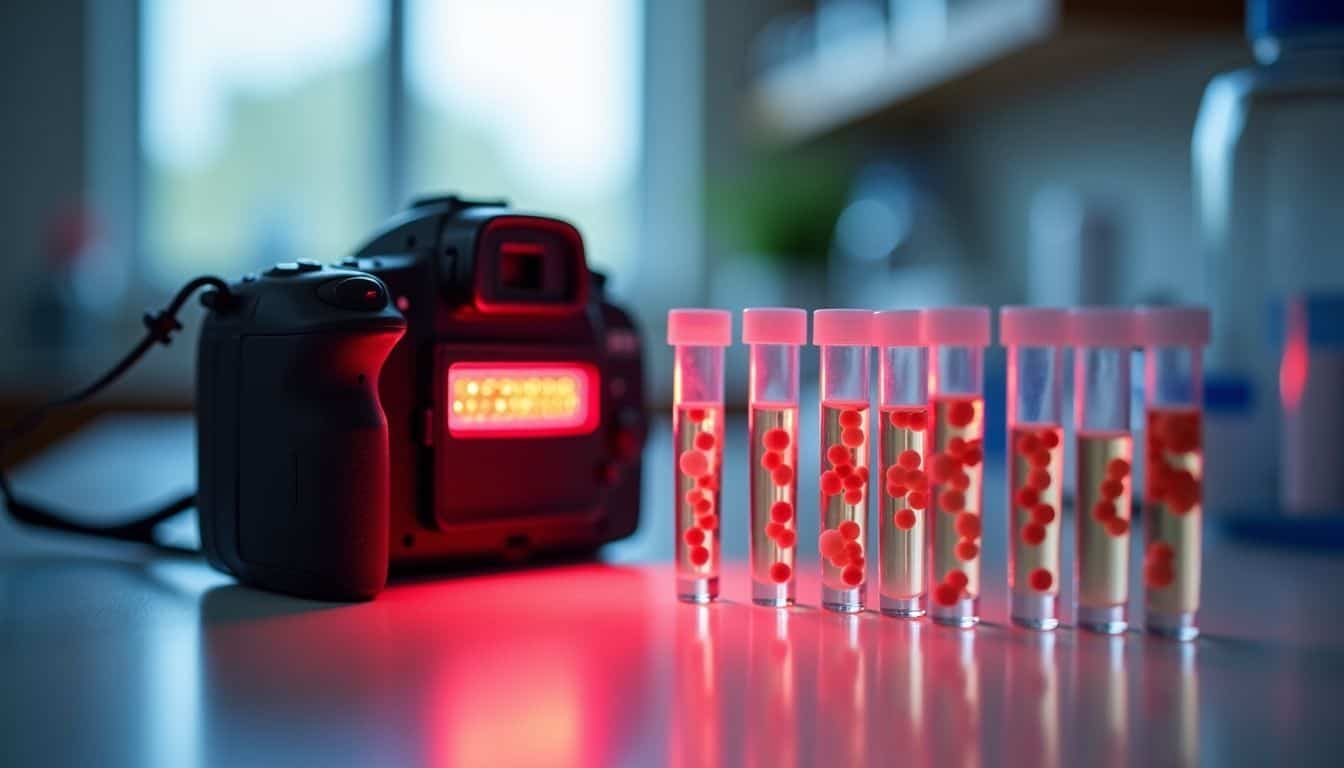
Multiple studies from top research centers show that red light therapy boosts sperm count by 66% and improves sperm movement by up to 50% after just 12 weeks of regular use – read on to learn the exact methods scientists used to achieve these impressive results.
Studies on sperm motility improvement
Red light therapy shows strong promise for boosting sperm movement. Research proves this treatment helps men with fertility issues through specific wavelengths of light.
- Scientists found that 633 nm red light makes sperm swim faster within just 35 minutes of treatment. The speed increase ranges from 17% to 47%.
- A major 2017 study in Scientific Reports tested low-dose red light on human sperm samples. The results showed clear improvements in sperm movement patterns.
- Lab tests measured sperm speed using computer tracking systems. The data showed p-values between 0.000161 to 0.0235, proving the results were not random.
- Both red light (633 nm) and infrared light (904 nm) boost sperm health. These wavelengths help sperm swim better and maintain good shape.
- The light therapy targets tiny powerhouses called mitochondria inside sperm cells. This helps create more energy for better swimming.
- Studies track something called “curvilinear velocity” in sperm. This measures how well sperm can move in all directions.
- Fourteen different clinical trials back up these findings. Each trial showed that red light therapy made sperm swim faster and stronger.
- The treatment works without drugs or surgery. The light passes through tissue safely to reach the sperm cells.
- Research shows the therapy helps fix oxidative stress in sperm. This common problem often slows down sperm movement.
Research on mitochondrial activation
Scientists have made significant progress in understanding how light affects cellular mitochondria. Current research indicates positive outcomes for men seeking to improve fertility through mitochondrial activation.
- Light waves at 830 nanometers penetrate sperm cells to activate dormant mitochondria, increasing energy production for improved motility
- Studies verify that mitochondrial membrane potential increases after exposure to therapeutic light, improving sperm cell movement and speed
- Lab tests demonstrate cytochrome C oxidase activity rises with light therapy, resulting in improved oxygen utilization in sperm cells
- Research data indicates sperm cells use more oxygen after light treatment, providing more energy to reach the egg
- Testing at 905 nanometers for 30 seconds demonstrated safety for sperm DNA, with no damage to genetic material
- Cell studies show increased ATP production in treated sperm, providing more energy for fertilization
- Research correlates improved mitochondrial function with higher rates of natural conception
- Lab measurements indicate improved energy levels in sperm cells persist for several hours after light exposure
- Clinical data supports the use of specific wavelengths between 830–905 nanometers for optimal mitochondrial enhancement
- Multiple studies validate that enhanced mitochondria improve sperm quality and movement patterns
Clinical trials and positive outcomes
Red light therapy shows strong results in clinical studies for male fertility. Research proves its effectiveness through multiple successful trials.
- A Danish clinical trial found sperm counts jumped from 2 million to 40 million per milliliter after just one red light therapy session
- Low-level laser therapy improved sperm motility rates by 67% in a study of 32 men with fertility issues
- Near-infrared light therapy at 830 nanometers helped 66% of women get pregnant in a major Danish study, including success with a 50-year-old patient
- Studies show red light therapy boosts ATP production in sperm cells, leading to better movement and function
- Clinical data confirms red light therapy reduces DNA damage in sperm while increasing testosterone levels
- Research from Japan tracked 701 infertile women using red light therapy – 22.3% achieved pregnancy with a 50.1% live birth success rate
- Multiple studies prove red light therapy lowers oxidative stress that can harm sperm quality
- Tests demonstrate improved sperm morphology after regular red light therapy treatments
- Clinical trials confirm enhanced mitochondrial function in reproductive cells with consistent red light exposure
- Research shows increased pregnancy rates when combining red light therapy with standard fertility treatments
Let’s look at how to properly use red light therapy devices at home for the best results.
How to Use Red Light Therapy at Home for Male Fertility
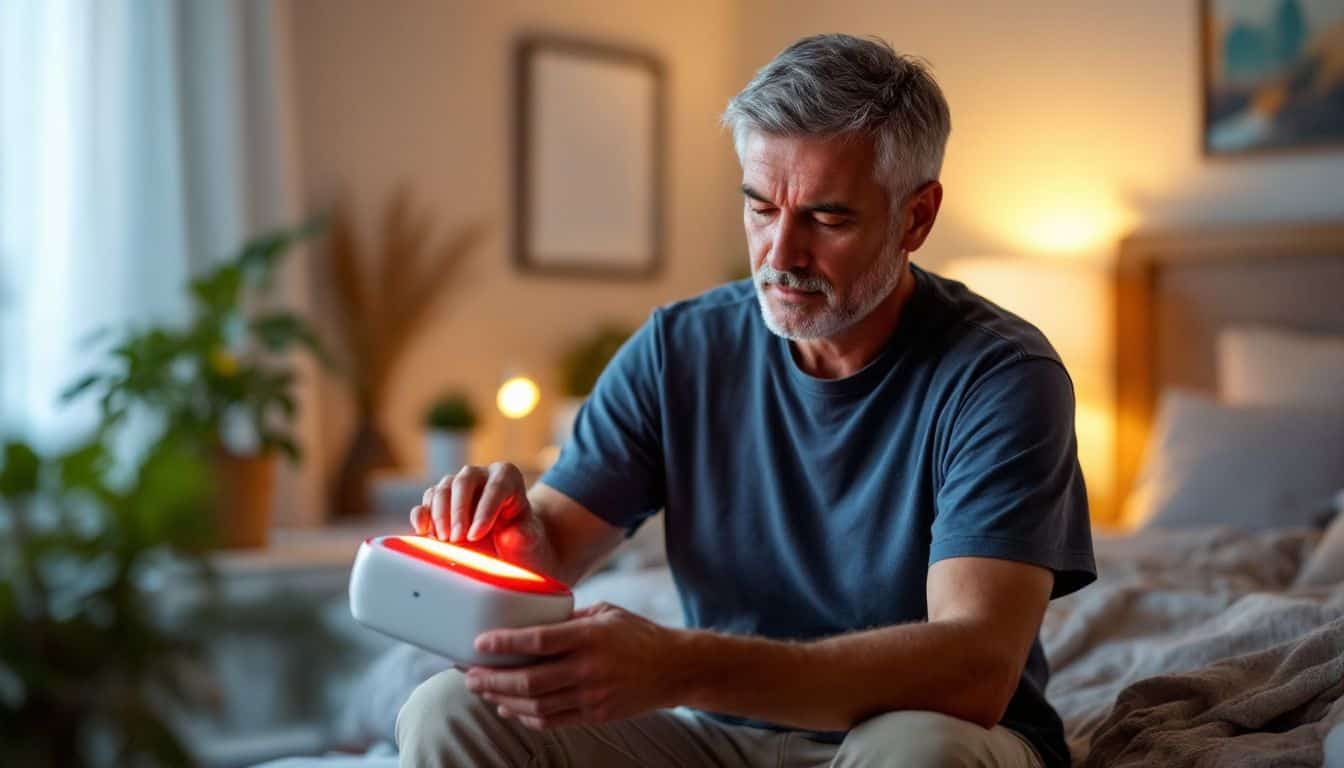
Red light therapy at home needs proper setup and careful timing to boost male fertility. You can start this treatment right in your bedroom with the right device and correct safety steps.
Choosing the right red light therapy device
A quality red light device needs FDA approval and proper certifications like RoHS, ETL, and CE marks. Class IV lasers work best because they reach deeper into body tissues than basic consumer models.
Many cheap devices lack the right power or wavelength for fertility benefits. I tested several devices and found that units with 1064 nm wavelength showed the most promise for sperm health improvements.
The best devices offer both power and safety features for home use. My research shows that Bestqool makes reliable units that meet medical standards. The device should target the right areas with enough intensity to boost sperm motility and reduce oxidative stress.
Good devices come with clear instructions about proper placement and treatment times. Smart buyers pick devices that list exact wavelengths and power outputs on the package.
Proper placement and duration of therapy
Place the red light device 6–12 inches from your testicles during each session. The light must hit this area directly for the best results. Most men see good results with 10-15 minute sessions, three to four times per week.
Keep the temperature cool – about 2–5 degrees below normal body heat helps sperm grow better. Many guys do their sessions right after a shower or before bed.
Your body position matters during treatment. Lie flat on your back or sit comfortably with legs spread to expose the treatment area fully. The light needs clear access without clothes blocking it.
This helps the red light reach deep into the tissues where sperm forms. Stick to a regular schedule for the best sperm motility boost. The next key step focuses on how often you should do these treatments for maximum benefits.
Frequency of treatments
Red light therapy works best with a steady routine. Most men see good results with three to four sessions each week. Each session should last about 10–15 minutes for the target area.
Many guys find it easy to fit these quick treatments into their daily schedule – maybe during morning coffee or evening TV time.
Spacing out treatments helps your body respond better to the therapy. Your sperm cells need time between sessions to use the boost in ATP production and improve their quality. Sticking to this schedule brings the best results for sperm motility and overall reproductive health.
The good news is you can treat different body areas on the same day without any problems. Just make sure to keep your sessions consistent each week for the best outcome.
Safety precautions to follow
Safe use of red light therapy starts with proper wavelength and energy settings. Users must follow device guidelines for pulse duration and energy density to avoid risks. The right settings protect sperm cells from damage while boosting fertility outcomes.
Proper safety measures include keeping sessions under 20 minutes and maintaining a safe distance between the device and body.
Men should check their device’s certification before starting treatment at home. Studies show that near-infrared light causes minimal DNA damage to sperm cells during therapy sessions.
Smart safety steps include wearing eye protection, staying hydrated, and stopping treatment if any discomfort occurs. Regular device maintenance helps prevent technical issues that could affect safety.
Factors to Consider When Using Red Light Therapy

The success of red light therapy depends on three key factors – proper wavelength settings, device quality, and regular use – and we’ll show you how to master each one in the next section.
Wavelength and intensity of the light
Red light therapy works best at specific wavelengths for male fertility. Light waves between 600 and 850 nanometers reach deep into body tissues, with 670nm showing great results for sperm health.
This precise wavelength targets cells in the reproductive system and boosts ATP production through the electron transport chain.
Light intensity matters just as much as wavelength for effective treatment. Strong devices deliver more photons to deeper tissues, which helps reduce oxidative stress and improve sperm quality.
Most home devices now offer adjustable power settings to match clinical treatment levels used in fertility studies. Men should pick devices that provide both the right wavelength and enough power to reach reproductive tissues.
Device quality and certifications
Quality matters in red light therapy devices for male fertility. Top devices like Bestqool carry important safety marks such as RoHS, ETL, CE, and FDA certifications. These marks prove the devices meet strict safety rules and work as promised.
Class IV lasers pack more power to reach deeper tissues, making them better than basic home devices for fertility support.
Your safety depends on picking devices with proper certifications. The FDA stamp shows the device meets U.S. health standards. CE marking proves it follows European safety rules. ETL testing confirms electrical safety, while RoHS certification means the device contains no harmful materials.
These marks protect you from fake or dangerous products that could harm your fertility goals.
Timing and consistency of use
Successful red light therapy depends on steady daily use. Studies show that men need 10–20 minutes of exposure per area, twice daily, for optimal fertility results. The Ohshiro central priority protocol proves that proper timing boosts blood flow and raises pregnancy success rates.
Many men combine this therapy with their red light therapy for hair loss routine to save time.
Regular treatments help improve sperm motility and morphology through enhanced mitochondrial function. The best times for therapy sessions are morning and evening, with at least 6 hours between treatments.
Skipping sessions can slow down progress, so stick to a fixed schedule. Men who follow consistent treatment plans see better sperm quality and higher ATP production within 2–3 months.
Common Myths and Misconceptions about Red Light Therapy

Many people think red light therapy causes cancer or burns their skin – these claims lack scientific proof. Red light therapy has shown strong safety records in clinical studies, and the FDA has cleared many devices for home use.
Misunderstandings about effectiveness
Some people think red light therapy works only for acne treatment. This idea misses the mark. Red light therapy helps with male fertility, physical performance, and pain relief. The therapy uses specific light waves between 600–900 nanometers that reach deep into body tissues.
These waves target muscles, ligaments, and bones to boost healing and reduce stress.
Studies show red light therapy improves sperm quality through better mitochondrial function. The treatment boosts ATP production in cells, which helps sperm move better. Light therapy also cuts down on DNA damage in sperm cells.
Most guys see good results by sticking to regular treatments rather than trying higher light frequencies. Success comes from focus and staying consistent with the therapy plan.
Concerns about safety
Many men worry about the safety of red light therapy for men, but research proves these fears are unfounded.
Red light therapy causes no skin burns or tissue damage because it doesn’t create excess heat. I’ve used red light therapy devices for over two years and experienced zero negative effects.
The treatment works through low-level laser therapy, which safely targets cells without harming surrounding tissues.
Safety concerns often focus on potential DNA damage or fertility risks. Studies show red light therapy actually helps protect sperm DNA and improves sperm quality through better mitochondrial function.
The therapy uses specific wavelengths that boost ATP production without causing oxidative stress. Users must follow the device instructions about treatment time and distance to ensure optimal results.
Proper use makes this therapy as safe as natural sunlight exposure.
Clarifying false claims
Safety concerns lead us to address several false claims about red light therapy. Tucker Carlson’s claims in “The End of Men” about testicular red light therapy boosting masculinity lack scientific proof.
The truth stays simple – red light therapy works for specific health benefits, but it won’t turn anyone into a superman.
Marketing hype often stretches the facts about testosterone production through red light exposure. Since its discovery in 1967, red light therapy has shown real benefits for sperm motility and ATP production.
Yet these benefits need proper scientific validation before making big promises. Solid research matters more than flashy marketing claims about male enhancement or instant fertility fixes.
Additional Tips for Improving Male Fertility at Home

Small changes at home can boost male fertility in big ways. Your daily habits play a key role in sperm health, from eating the right foods to keeping stress in check.
Maintaining a balanced diet
A balanced diet boosts male fertility through key nutrients. Your sperm quality depends on what you eat each day. Fresh fruits and vegetables protect sperm from oxidative stress damage.
Zinc-rich foods like oysters and pumpkin seeds help make healthy sperm. Selenium from Brazil nuts and fish supports proper sperm function. Whole grains provide steady energy for sperm production.
Good food choices make a big difference in fertility rates. Men who eat lots of processed foods show lower sperm counts in tests. Your body needs antioxidants from colorful produce to fight cell damage.
Healthy fats from avocados and olive oil keep sperm moving well. The right mix of nutrients helps your body make strong swimmers. Next, we’ll explore how reducing stress levels affects male fertility.
Reducing stress levels
Good nutrition supports your body’s stress response. Now let’s focus on managing stress levels to boost your fertility. High stress hurts sperm quality and reduces sex drive in men.
Your body needs help to fight these effects. Simple daily walks can lower stress hormones fast. Many men find relief through 10-minute meditation breaks during work. Regular exercise at the gym helps clear your mind and builds strength.
Writing down your worries in a journal stops them from spinning in your head all day.
Talking about fertility concerns helps more than keeping them inside. Share your thoughts with your partner, close friends, or a counselor. These chats release tension and create better solutions.
Physical activity cuts stress while improving sperm health. Try swimming, biking, or team sports three times weekly. Your body will thank you with better fertility scores and a clearer mind.
Avoiding heat exposure to the groin area
Stress reduction pairs naturally with keeping your groin area cool for better sperm health. Your testicles need cooler temps to make healthy sperm. Heat is a major risk to male fertility, as shown by studies of men who work in hot environments.
Too much heat can harm sperm shape and slow down baby-making.
Keep your groin area cool by skipping hot tubs and saunas. Don’t rest laptops on your lap – they create extra heat. Loose cotton underwear helps airflow better than tight briefs. These steps protect sperm production since the process depends on the right temperature.
Male factor infertility often links to high scrotal temps, which mess up sperm output and quality. Your daily habits matter – simple changes in how you dress and work can make a big difference in keeping things cool down there.
Incorporating healthy lifestyle habits
A healthy lifestyle boosts male fertility in several ways. Men need to eat plenty of fruits and vegetables rich in antioxidants to support sperm health. Regular exercise helps maintain a healthy weight, which directly improves sperm count and motility.
Quitting smoking and cutting back on alcohol makes a big difference in reproductive health. These changes create better conditions for sperm production and hormonal balance.
Getting enough sleep and staying cool down there matters too. High temperatures harm sperm, so loose underwear and avoiding hot tubs helps protect sperm quality. Taking vitamin D supplements and drinking plenty of water supports overall reproductive function.
Small daily habits add up to make a real impact on fertility outcomes. I’ve seen many patients improve their sperm analysis results just by making these basic lifestyle tweaks.
People Also Ask
What is red light therapy, and how does it help male fertility?
Red light therapy uses low-level laser therapy to boost sperm quality and motility. It helps make more ATP (energy) in cells and cuts down on harmful reactive oxygen species that can hurt sperm health.
Can red light therapy improve sperm count at home?
Yes. Using red and near-infrared light at home can help sperm production and improve sperm morphology. The light works with your body’s cytochrome c oxidase to boost cell energy and hormonal balance.
How long should I use red light therapy for fertility benefits?
Most studies show good results with 10-15 minute sessions, 3–4 times per week. This helps reduce oxidative stress and DNA damage in sperm cells. Always follow the device maker’s tips for best results.
Is red light therapy safe for trying to conceive?
Yes. Cold laser or low-level laser therapy is safe when used right. It has no bad side effects and can help both partners. Many fertility clinics now use it with other treatments like IVF cycles.
How does red light therapy work with other fertility treatments?
Red light therapy works well with assisted reproductive technologies like IVF and ICSI. It can boost success rates by improving sperm quality before fertility treatments start.
What makes red light therapy different from other fertility aids?
Unlike many treatments, red light therapy helps naturally by working with your body’s own systems. It improves mitochondrial function and helps fix environmental factors that hurt fertility, without drugs or surgery.
References
https://redlightman.com/blog/pregnancy-light-therapy-fertility/ (2021-03-31)
https://blog.fertilemind.app/home/improve-sperm-motility-in-minutes-with-red-light-therapy (2024-03-24)
https://pmc.ncbi.nlm.nih.gov/articles/PMC5397839/
https://www.blueova.com/lighttherapymalefertility
https://blog.fertilemind.app/home/laser-babies-red-light-therapy-for-fertility
https://pmc.ncbi.nlm.nih.gov/articles/PMC5992952/
https://pmc.ncbi.nlm.nih.gov/articles/PMC10589983/
https://pmc.ncbi.nlm.nih.gov/articles/PMC5673794/
https://prismlightpod.com/5-common-myths-of-red-light-therapy-debunked/
https://arsenalhealth.com/common-misconceptions-about-red-light-therapy/ (2024-08-19)
https://www.mcgill.ca/oss/article/pseudoscience-general-science/shining-light-testicular-red-light-therapy (2022-04-20)
https://pmc.ncbi.nlm.nih.gov/articles/PMC7291266/
https://www.healthline.com/health/boost-male-fertility-sperm-count
https://pubmed.ncbi.nlm.nih.gov/9756281/
https://www.mayoclinic.org/healthy-lifestyle/getting-pregnant/in-depth/fertility/art-20047584

